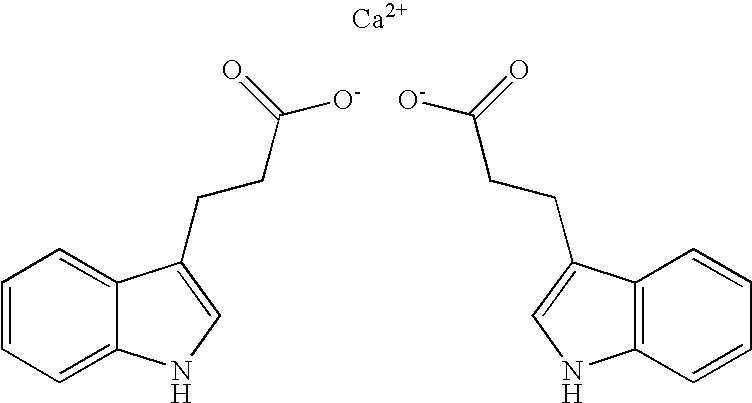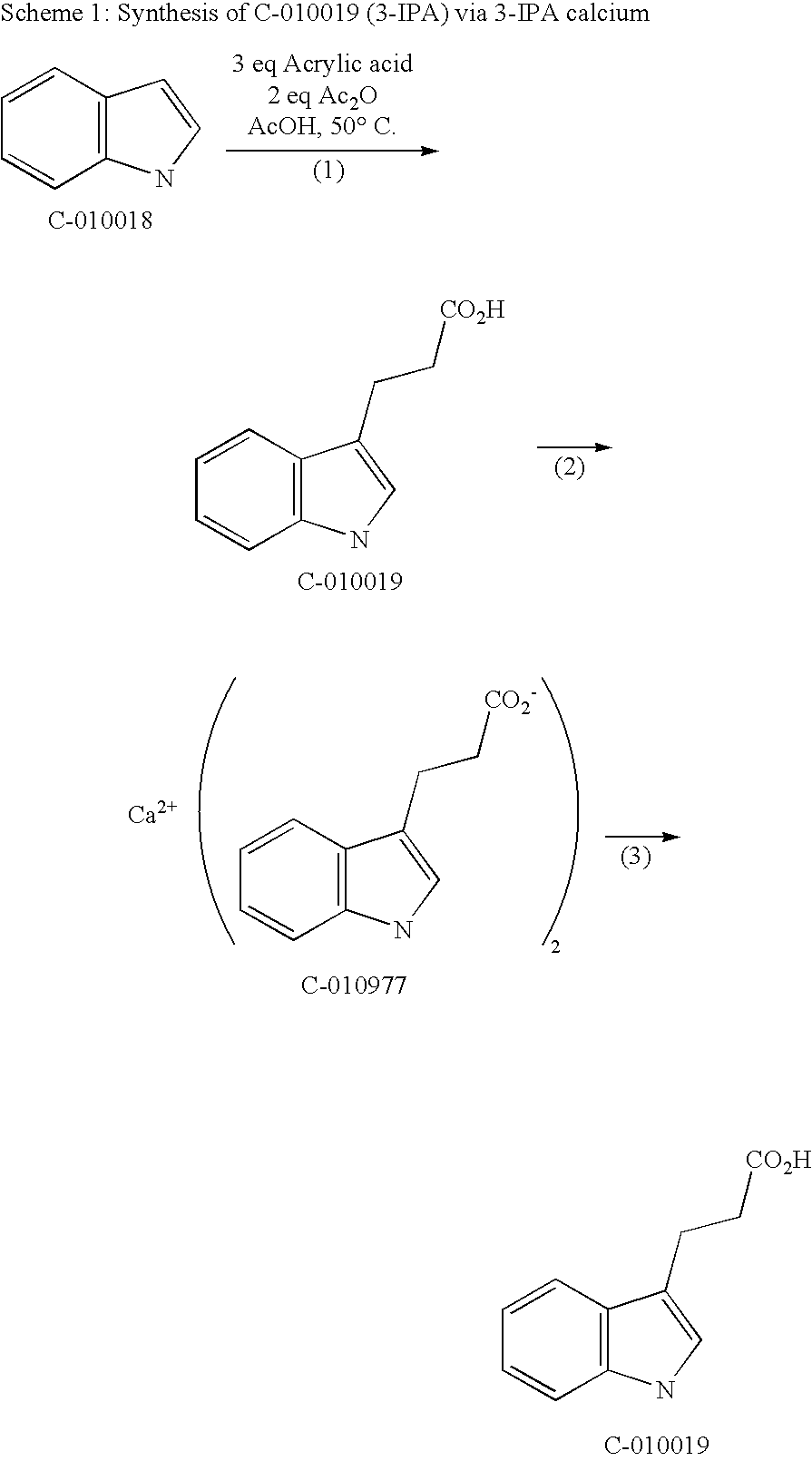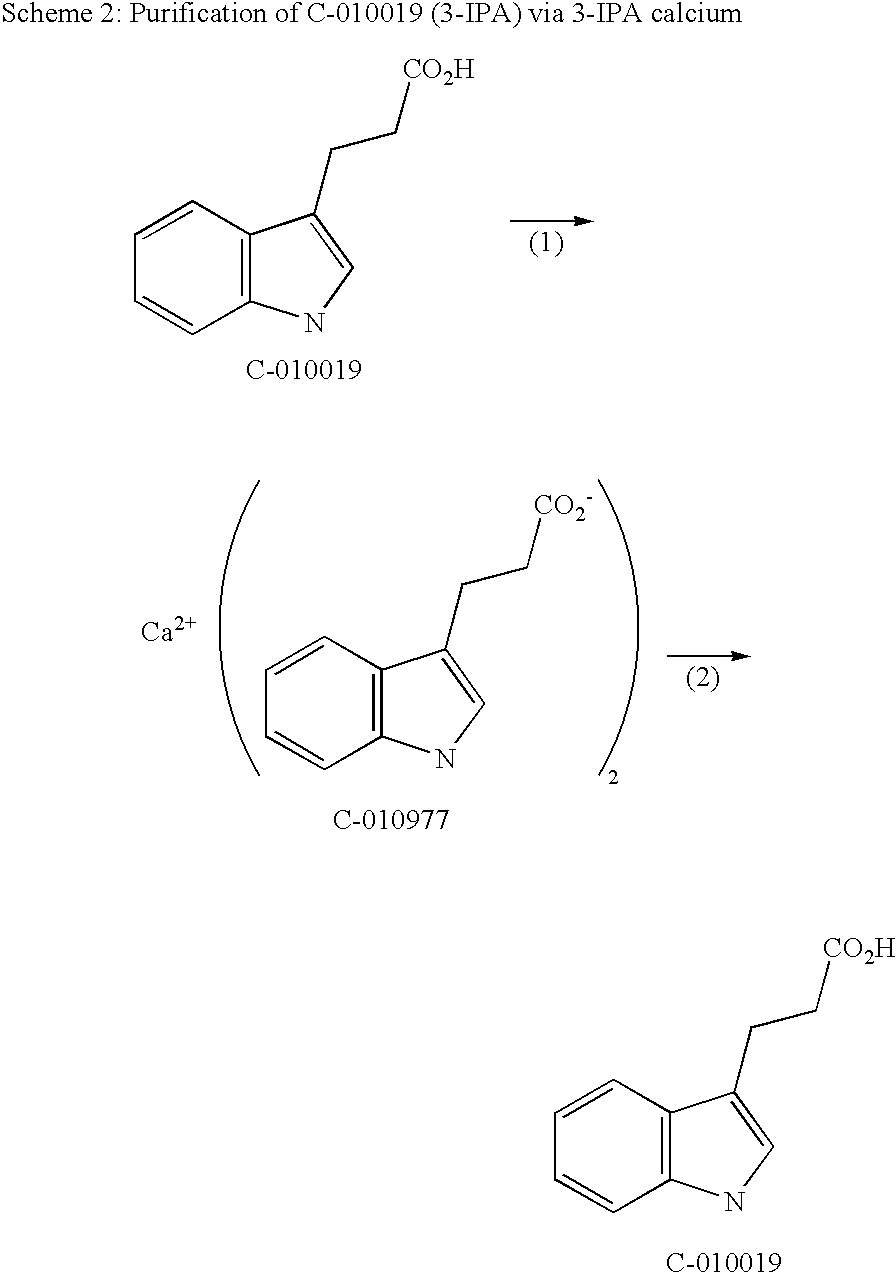3-(3-indolyl) propionic acid calcium salt and method of making 3-(3-indolyl) propionic acid free acid therefrom
a technology of propionic acid and calcium salt, which is applied in the field of 3(3indolyl) propionic acid calcium salt and the method of making 3(3indolyl) propionic acid free acid therefrom, can solve the problems of ad, no cure for ad, and ineffective attempts to influence the cholinergic system,
- Summary
- Abstract
- Description
- Claims
- Application Information
AI Technical Summary
Benefits of technology
Problems solved by technology
Method used
Image
Examples
example 1
Synthesis of 3-IPA Using Acrylic Acid and a 3-IPA Calcium Intermediate for Purification
[0080]
[0081]Indole (8.015 kg), acetic acid (16 L), acrylic acid (3 eq., 14 L) and acetic acid anhydride (2 eq., 13 L) were heated for 64 hours to 50° C. under a nitrogen atmosphere. (Step 1, Scheme 1). The indole showed a conversion to 3-IPA of 98.6%. The reaction mixture was cooled to 18-20° C., water (22.5 L) was added and stirring was continued for 18 hours at 18-20° C. The resulting mixture showed no residual anhydrides, and the purity of 3-IPA was found to be 69.32 area % by high performance liquid chromatography (HPLC). Heptane (17.2 L) was added and 45 L of acetic acid / water were removed by azeotropic distillation (p=90-140 mbar, IT=28-32° C., OT=60-70° C.). 17 L of heptane were removed by distillation (p=54-80 mbar, OT=60° C., IT=33-42° C.). When the temperature of the reaction mixture reached 20° C., ethyl acetate (25 L) and water (69 L) were added. At a temperature between 0-10° C., the ...
example 2
Synthesis of 3-IPA Using Acrylic Acid and a 3-IPA Calcium Intermediate for Purification
[0083]Indole (58.59 g), acetic acid (120 mL), acrylic acid (3 eq., 103 mL) and acetic acid anhydride (2 eq., 94 mL) were heated for 43 hours to 50° C. under a nitrogen atmosphere. (Step 1, Scheme 1). The indole showed a conversion to 3-IPA of 97.9%. The reaction mixture was cooled to 20° C., water (164 mL) was added, and stirring was continued for 18 hours at 20° C. The resulting mixture showed no residual anhydrides. The purity of 3-IP A was found to be 72.12 area % by HPLC. Heptane (126 mL) was added and 230 mL of the acetic acid / water mixture was removed by azeotropic distillation (p=119 mbar, IT=21-40° C., OT=70° C). 92 mL of heptane were removed by distillation (119 mbar, OT=70° C., IT=40-50° C.). When the temperature of the reaction mixture reached 20° C., ethyl acetate (182 mL) and water (502 mL) were added. When the reaction mixture reached a temperature between 5° C. and 11° C., 30% sodiu...
example 3
Synthesis of 3-IPA Using a 3-IPA Calcium Intermediate for Purification
[0085]
[0086]14.421 kg 3-IPA (97.4 area % by HPLC) were dissolved in water (51 L) and ammonium hydroxide solution (12.6 L, 25%). The resulting solution had a pH of 9. Ethyl acetate (51 L) was added. When the water / ethyl acetate mixture reached a temperature of 20° C., a saturated calcium chloride solution (20 L) was added within 1 hour and a suspension was formed. (Step 1, Scheme 3). The suspension was stirred at 20° C. for 14 hours. 3-IPA calcium was collected by filtration and washed with water (14.5 L) and ethyl acetate (2×14.5 L). The wet filter cake containing 99.74 area % 3-IPA calcium as determined by HPLC was dissolved in acetic acid (50.5 L) at 18-19° C. and water (143 L) was added within 1 hour. (Step 2, Scheme 2). The suspension was heated to 75° C. and a clear solution was obtained. The reaction mixture was cooled down to 0° C. within 4 hours. The suspension was stirred overnight at 0° C. Crude 3-IPA wa...
PUM
| Property | Measurement | Unit |
|---|---|---|
| temperature | aaaaa | aaaaa |
| temperature | aaaaa | aaaaa |
| temperature | aaaaa | aaaaa |
Abstract
Description
Claims
Application Information
 Login to View More
Login to View More - R&D
- Intellectual Property
- Life Sciences
- Materials
- Tech Scout
- Unparalleled Data Quality
- Higher Quality Content
- 60% Fewer Hallucinations
Browse by: Latest US Patents, China's latest patents, Technical Efficacy Thesaurus, Application Domain, Technology Topic, Popular Technical Reports.
© 2025 PatSnap. All rights reserved.Legal|Privacy policy|Modern Slavery Act Transparency Statement|Sitemap|About US| Contact US: help@patsnap.com



